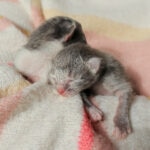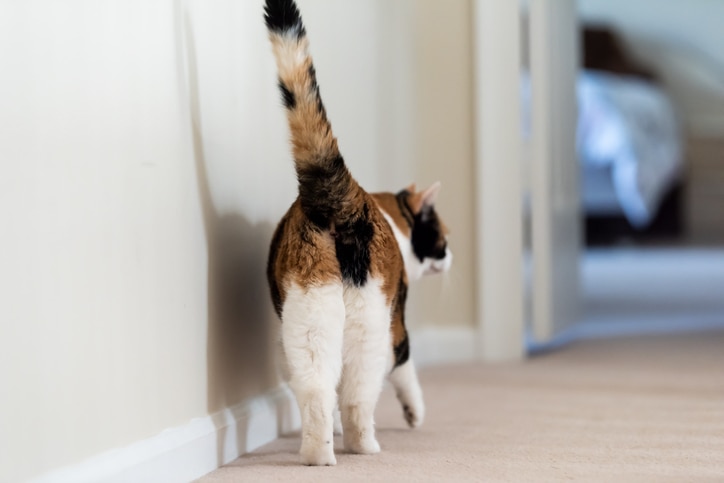Kidney Disease in Cats: Stages, Symptoms, and Treatment

Photo by gorodenkoff/Getty
Of the variety of health conditions that affect our sweet felines, cat kidney disease is one of the most common. In fact, it’s one of the leading causes of death in cats.
Because poor kidney function in cats isn’t fully understood and isn’t easily preventable, frequent checkups and an early diagnosis are crucial. This allows you to monitor and mitigate symptoms to lengthen your kitty’s life span and ensure a better quality of life.
With veterinarian insights, we’re covering some of the basics of kidney disease in cats, including clinical signs to watch for and how to best move forward after a diagnosis.
What Is Kidney Disease in Cats?
Kidneys are vitally important organs that serve as a filtering system in bodies.
When we talk about kidney disease—including acute renal failure and chronic kidney failure—we’re referring to a condition where the kidneys aren’t operating as they should, says Mandi Shearhart, DVM, Fayetteville, Arkansas-based veterinarian for Best Friends Animal Society, an animal welfare organization headquartered in Kanab, Utah.
This means the kidneys are no longer able to adequately eliminate toxins, conserve water, or regulate the balance of some electrolytes, minerals, and proteins.
Additionally, loss of kidney function can also impact the production of certain hormones and affect blood pressure.
Acute Kidney Failure
In some instances, kidney disease is acute.
“This means it comes on suddenly and is typically caused by a single event, such as a toxin exposure, trauma, or bacterial infection,” Dr. Shearhart says.
For example, acute renal failure (the technical term for acute kidney failure) can happen if your cat gets into something they shouldn’t eat, such as antifreeze or lilies.
With quick and aggressive treatment, it’s sometimes possible to correct the kidney damage and get your cat back to their usual self.
Chronic Kidney Disease
Chronic kidney disease (CKD) refers to damage done to the kidneys over time and is generally associated with cats 7 years of age or older.
The International Renal Interest Society (IRIS) has established four stages of chronic kidney disease based on laboratory values, which are simply referred to as stages 1, 2, 3, and 4.
Over time, a cat’s kidney damage is expected to progress through these stages until the cat goes into crisis.
In early-stage kidney disease, symptoms are absent or mild and treatment focuses primarily on slowing the progression of disease and managing concurrent conditions like high blood pressure.
Later stages are considered more severe and require more aggressive management of symptoms to improve quality of life and longevity.
Dietary modifications, medications, and hydration are all important tools in managing kidney disease.
End-Stage Renal Disease
Once kidney function is lost, it usually does not come back—and toxins building up in the blood start to affect other organs in the body, explains Sarah Wooten, DVM, veterinarian and certified veterinary journalist.
“Cats who have end-stage kidney failure usually fail within a couple of days of this happening,” Dr. Wooten says. “It is heartbreaking to see alarmed pet parents in the exam room with their dehydrated, debilitated, and very, very sick kitty who seemed perfectly normal last week.”

nurulanga via Getty Images
Causes of Kidney Disease in Cats
Though experts have theories about what can lead to chronic kidney disease and kidney failure in cats, the exact causes for individual cats are not always understood.
“We do know that chronic kidney disease is often associated with chronic health issues such as dental disease, which can be addressed and managed before their effects on the kidneys have become detrimental,” notes Dr. Shearhart. She adds that it’s a disease associated with older cats, and that it might be caused by aging organs that aren’t working as efficiently as they once did.
Acute kidney failure, on the other hand, may be easier to determine because it’s usually brought on by a single event, such as:
- Exposure to a toxic substance
- Trauma/injury to the kidney
- Bacterial infection
Symptoms of Kidney Disease in Cats
Drinking lots of water and peeing excessively are the classic and often earliest signs of kidney failure in cats.
Other symptoms may include:
- Weight loss
- Loss of appetite
- Vomiting
- Decreased energy
- Ulcers in the mouth (in advanced cases)
- Bad breath (in advanced cases)
Over time, cats with chronic kidney failure will experience a reduction in red blood cells, which can ultimately lead to anemia. Symptoms of anemia include lethargy and pale gums.
Kidney failure can also lead to hypokalemia, or low potassium levels. This can affect your cat’s muscles and nerves, and cause them to become weaker, which can look like difficulty getting up or walking, lethargy, or uncoordinated movements.
In end-stage kidney failure, your cat will not be like their normal self at all. They may:
- Not be able to control their bowels or urinary tract
- Have a strong body odor
- Not want to eat or drink
- Have persistent vomiting
- Withdraw or hide
- Experience confusion
Some cats may not be able to move or walk, while others may pace or seem restless.
Did you know? When it comes to their behavior, cats are true masters of disguise. Because of their instinct to survive, they will attempt to act healthy until they are physically unable to do so. This instinct drives them to act normal and to hide themselves when they can’t. That’s why regular vet checkups and closely monitoring their behavior at home are especially important—to catch early signs of health troubles that may not be obvious.
Diagnosing Kidney Disease in Cats
Kidney disease must be diagnosed by a veterinarian.
According to IRIS, kidney staging is determined after running blood tests. These tests measure creatinine, a waste product in the blood; and SDMA (symmetric dimethylarginine) concentration, aka the levels of a biomarker that can reflect kidney function; or, ideally, both. For greater insights, they’ll also do a urinalysis and take their blood pressure.
Based on results from the blood panel and urine sample, your veterinarian can determine if your cat has kidney disease and whether it’s early stage, late stage, or somewhere in between.
“[These tests] may be performed as part of a wellness screening or in response to an illness or concern,” says Dr. Wooten.
Depending on your veterinarian and the reason for running these tests, they may be run in the clinic or sent to an outside laboratory. In-clinic results can come as soon as 20–30 minutes, while results from an outside lab usually come within a few days.
There may also be follow-up laboratory tests or additional tests like an ultrasound to confirm the diagnosis of kidney disease and to determine stage and management strategy.
Treatment for Kidney Disease in Cats
If your cat has been diagnosed with kidney disease, there are a variety of treatment options depending on the stage of disease.
Ultimately, your goal is to slow disease progression, minimize symptoms, and prioritize their comfort and quality of life.
“Chronic kidney disease is a condition that cannot be cured, but rather managed to keep your pet comfortable and support their kidneys for as long as possible,” Dr. Shearhart says. “The treatment plan will vary based on the individual cat, pet parent, and stage of disease.”
Some cats may benefit from medications, while others may be managed on a therapeutic diet and fluid support alone.
Dr. Shearhart says cats with kidney disease should consume more water to stay hydrated. This helps support their kidneys and allows them to work better. For that reason, access to plenty of fresh water is very important.
A flowing water fountain, such as PetSafe® Drinkwell, may be more enticing for your cat than still water in a bowl. Offering multiple water sources in different areas of the house can also help cats drink more water.
Fluid loss and dehydration are a natural consequence of declining kidney function. If cats are unable to keep up with their fluid needs through drinking, additional fluids can be given under their skin with veterinary guidance.
“Once your cat is diagnosed with kidney disease, your veterinarian will discuss a treatment plan that best fits your individual situation,” Dr. Shearhart says “This then may be altered and adjusted, based on recheck visits and how your cat is doing.”
Recommended Product
What To Feed a Cat With Kidney Disease
For a good quality of life, it is also important to keep cats with kidney disease in good body condition. This means feeding your cat a diet with just the right amount of protein to fuel strong muscles, drive metabolism, and support the body.
“For my patients with early cat kidney disease, I recommend feeding them a combination of high-quality canned and dry cat food, and lots of fresh water,” Dr. Wooten says. “Cats with kidney disease dehydrate easily, so providing some moisture in the form of canned food is a good idea.”
She says cats with kidney disease also benefit from a high-quality fish oil supplement. In humans, fish oil has shown to have a protective effect for kidneys.
Recommended Products
For food, she recommends a therapeutic diet like Hills® Prescription Diet® k/d Kidney Care. Hill’s is formulated to protect kidney function, maintain muscle mass, and improve the intestinal biome. Therapeutic diets require authorization from your veterinarian.
Recommended Products
“The problem with many kidney diets is that sick cats become very picky, and it can get hard to switch their food or get them to eat at all,” Dr. Wooten says.
“For cats who will not transition to a kidney diet,” Dr. Wooten says, “I recommend supporting them with an intestinal phosphate binder, like the Vetoquinol Epakitin® Supplement, but only under the guidance of your local veterinarian.”
Recommended Product
Cat Kidney Disease Prognosis
While acute kidney disease can be treated if caught in time, chronic kidney disease is incurable, and therefore relies on ongoing management to keep your cat comfortable and to prolong their life.
With proper care and routine vet visits, cats can live for a long time with kidney disease—sometimes years—especially when the disease is caught in early stages.
Unfortunately, though, kidney disease is progressive and will impact cat health more and more as time goes by.
For cats who are in end-stage kidney failure and are suffering, and unless they are a candidate for dialysis and kidney transplant, humane euthanasia is often recommended because of poor quality of life and lack of a cure.
Preventing Kidney Disease in Cats
Dr. Shearhart says you can help prevent acute kidney damage by:
- Keeping your cat away from toxins
- Keeping them safe from trauma
- Seeing your veterinarian promptly if you notice abnormalities in water consumption, urination, appetite, or behavior
Unfortunately, there is no guaranteed prevention for chronic kidney disease or chronic renal failure.
However, routine veterinary care may prevent or improve other diseases that can impact the development of renal disease.
In addition, early diagnosis can help delay the progression of disease, and symptom management can improve your cat’s prognosis and quality of life.
The most important thing you can do for a cat with kidney disease is to work closely with your veterinarian. Cats with early kidney disease need to be seen every three to six months for an exam, weight check, blood tests, urinalysis, and nutritional adjustments or recommendations. Learn more about choosing the best cat foods for your feline depending on their age and health.
This content was medically reviewed by Chewy vets.

















